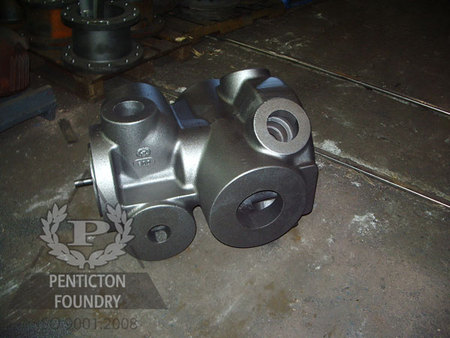Ductile Iron ASTM A536 Grade 60-40-18
on November 28, 2017Related Standards-SAE J434C D4512; ISO 1083
ASTM A536 60-40-18 is a nodular Iron with a mostly ferritic microstructure and mechanical properties comparable to low alloy steels. Ductile iron 60-40-18 is one grade in a family of many. Chemistry requirements are not specified in the ASTM A536 standard. Chemistry and hardness listed in this spec would be typical for a Grade 60-40-18.
Composition
|
|
C |
Mn |
Si |
Cr |
Ni |
Cu |
Mg |
|
Min% |
3.4 |
|
2.00 |
|
|
|
0.025 |
|
Max% |
3.8 |
0.3 |
2.5 |
0.08 |
0.5 |
0.2 |
0.055 |
Chemistry control is one approach to making fully ferritic ductile iron. Minimizing pearlitizing elements is important when pouring ASTM A536 60-40-18 material. Using good, clean steel scrap and quality pig iron allows a ferritic microstructure to be achieved.
Physical and Mechanical Properties
|
UTS (psi) |
60000 |
|
YS (psi) |
40000 |
|
%Elongation min |
18% |
|
Hardness |
|
|
Density lb/in3 (g/cm3) |
0.256(7.1) |
|
Thermal Conductivity Btu/hr·ft·F (W/m·K) |
250(36) for Ferritic grades, will change with an increase in pearlite, approx. 20% less |
|
Specific Heat at 70F Btu/lb·F (J/Kg·k) |
0.110(461) |
|
Coefficient of Thermal Expansion Ɛ/F(Ɛ/C)X106 average between 68-212F |
6.4 (11.5) |
|
Melting Temperature (F) |
2100 F |
|
Compressive Strength Ksi (MPa) |
429 (2960) |
Heat Treatment 
Heat treatment is another method used to achieve fully ferritic ductile iron. Most foundries achieve the ferritic microstructure by a full anneal heat treatment, which can increase the cost of this ductile iron alloy. The heat treatment would involve annealing the castings to break down carbides, as well as holding at temperature to precipitate carbon to a graphite particle. Penticton Foundry does have full heat treatment capabilities and will heat treat this alloy if/when required.
Impact Properties
Ductile iron impact properties are microstructure dependent. Impact requirements are not specified in the ASTM A536 60-40-18 standard. For more information about impact testing of ductile iron please refer to the ISO 1083 standard. The impact requirement is 12J at -20⁰C. To achieve the 12J impact result the pearlite should be less than 15% of the microstructure. Through chemistry controls and heat treatment these properties can be met.
Read “Impact Values of Ductile Iron for Design Engineers” for more information.
Some Applications Include
- Brakes
- Gear boxes
- Frames
- Oil and gas parts
- Pumping parts
- Compressor parts
- Mining parts
- Winch parts
- Wind Energy

